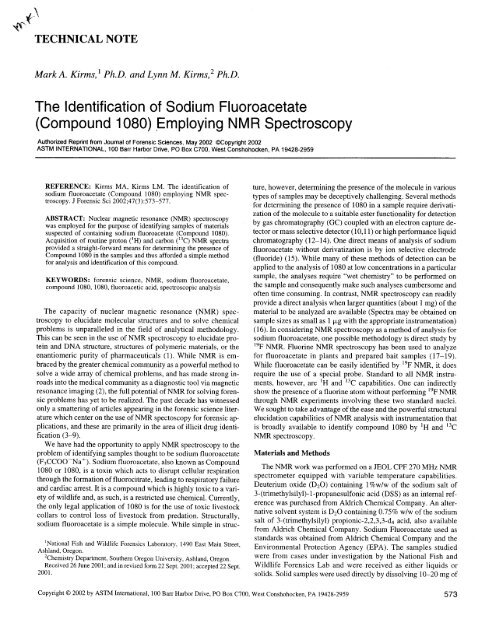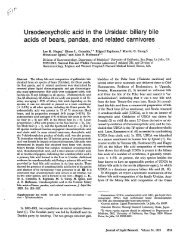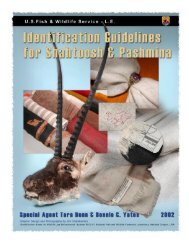The Identification of Sodium Fluoroacetate (Compound 1080 ...
The Identification of Sodium Fluoroacetate (Compound 1080 ...
The Identification of Sodium Fluoroacetate (Compound 1080 ...
You also want an ePaper? Increase the reach of your titles
YUMPU automatically turns print PDFs into web optimized ePapers that Google loves.
~<br />
(\<br />
TECHNICAL NOTE<br />
<strong>The</strong> <strong>Identification</strong> <strong>of</strong> <strong>Sodium</strong> <strong>Fluoroacetate</strong><br />
(<strong>Compound</strong> <strong>1080</strong>) .Employing NMR Spectroscopy<br />
Authorized Reprint from Journal <strong>of</strong> Forensic Sciences, May 2002 ©Copyright 2002<br />
ASTM INTERNATIONAL, 100 Barr Harbor Drive, PO Box C700, West Conshohocken, PA 19428-2959<br />
REFERENCE: Kirms MA, Kirms LM, <strong>The</strong> identification <strong>of</strong><br />
sodium fluoro acetate (<strong>Compound</strong> <strong>1080</strong>) employing NMR spectroscopy.<br />
J Forensic Sci 2002;47(3):573-577.<br />
ABSTRACT: Nuclear magnetic resonance (NMR) spectroscopy<br />
was employed for the purpose <strong>of</strong> identifying samples <strong>of</strong> materials<br />
suspected <strong>of</strong> containing sodium fluoroacetate (<strong>Compound</strong> <strong>1080</strong>).<br />
Acquisition <strong>of</strong> routine proton CH) and carbon (l3C) NMR spectra<br />
provided a straight-forward means for determining the presence <strong>of</strong><br />
<strong>Compound</strong> <strong>1080</strong> in the samples and thus afforded a simple method<br />
for analysis and identification <strong>of</strong> this compound.<br />
KEYWORDS: forensic science, NMR, sodium fluoroacetate,<br />
compound <strong>1080</strong>, <strong>1080</strong>, fluoroacetic acid, spectroscopic analysis<br />
<strong>The</strong> capacity <strong>of</strong> nuclear magnetic resonance (NMR) spectroscopy<br />
to elucidate molecular structures and to solve chemical<br />
problems is unparalleled in the field <strong>of</strong> analytical methodology.<br />
This can be seen in the use <strong>of</strong> NMR spectroscopy to elucidate protein<br />
and DNA structure, structures <strong>of</strong> polymeric materials, or the<br />
enantiomeric purity <strong>of</strong> pharmaceuticals (1). While NMR is embraced<br />
by the greater chemical community as a powerful method to<br />
solve a wide array <strong>of</strong> chemical problems, and has made strong inroads<br />
into the medical community as a diagnostic tool via magnetic<br />
resonance imaging (2), the full potential <strong>of</strong>NMR for solving forensic<br />
problems has yet to be realized. <strong>The</strong> past decade has witnessed<br />
only a smattering <strong>of</strong> articles appearing in the forensic science literature<br />
which center on the use <strong>of</strong> NMR spectoscopy for forensic applications,<br />
and these are primarily in the area <strong>of</strong> illicit drug identification<br />
(3-9).<br />
We have had the opportunity to apply NMR spectroscopy to the<br />
problem <strong>of</strong> identifying samples thought to be sodium fluoroacetate<br />
(F3CCOO-Na+). <strong>Sodium</strong> fluoroacetate, also known as <strong>Compound</strong><br />
<strong>1080</strong> or <strong>1080</strong>, is a toxin which acts to disrupt cellular respiration<br />
through the formation <strong>of</strong> fluorocitrate, leading to respiratory failure<br />
and cardiac arrest. It is a compound which is highly toxic to a variety<br />
<strong>of</strong> wildlife and, as such, is a restricted use chemical. Currently,<br />
the only legal application <strong>of</strong> <strong>1080</strong> is for the use <strong>of</strong> toxic livestock<br />
collars to control loss <strong>of</strong> livestock from predation. Structurally,<br />
sodium fluoroacetate is a simple molecule. While simple in struc-<br />
INational Fish and Wildlife Forensics Laboratory, 1490 East Main Street,<br />
Ashland, Oregon,<br />
2ChemistryDepartment, Southern Oregon University, Ashland, Oregon.<br />
Received 26 June 2001; and in revised form 22 Sept. 2001; accepted 22 Sept.<br />
2001.<br />
ture, however, determining the presence <strong>of</strong> the molecule in various<br />
types <strong>of</strong> samples may be deceptively challenging. Several methods<br />
for determining the presence <strong>of</strong> <strong>1080</strong> in a sample require derivatization<br />
<strong>of</strong> the molecule to a suitable ester functionality for detection<br />
by gas chromatography (GC) coupled with an electron capture detector<br />
or mass selective detector (10,11) or high performance liquid<br />
chromatography (12-14). One direct means <strong>of</strong> analysis <strong>of</strong> sodium<br />
fluoroacetate without derivatization is by ion selective electrode<br />
(fluoride) (15). While many <strong>of</strong> these methods <strong>of</strong> detection can be<br />
applied to the analysis <strong>of</strong> <strong>1080</strong> at low concentrations in a particular<br />
sample, the analyses require "wet chemistry" to be performed on<br />
the sample and consequently make such analyseS cumbersome and<br />
<strong>of</strong>ten time consuming. In contrast, NMR spectroscopy can readily<br />
provide a direct analysis when larger quantities (about 1 mg) <strong>of</strong> the<br />
material to be analyzed are available (Spectra may be obtained on<br />
sample sizes as small as 1 f.lgwith the appropriate instrumentation)<br />
(16). In considering NMR spectroscopy as a method <strong>of</strong> analysis for<br />
sodium fluoroacetate, one possible methodology is direct study by<br />
19FNMR. Fluorine NMR spectroscopy has been used to analyze<br />
for fluoroacetate in plants and prepared bait samples (17-19).<br />
While fluoroacetate can be easily identified by 19FNMR, it does<br />
require the use <strong>of</strong> a special probe. Standard to all NMR instruments,<br />
however, are lH and l3C capabilities. One can indirectly<br />
show the presence <strong>of</strong> a fluorine atom without performing 19FNMR<br />
through NMR experiments involving these two standard nuclei.<br />
We sought to take advantage <strong>of</strong> the ease and the powerful structural<br />
elucidation capabilities <strong>of</strong> NMR analysis with instrumentation that<br />
is broadly available to identify compound <strong>1080</strong> by IH and l3C<br />
NMR spectroscopy.<br />
<strong>The</strong> NMR work was performed on a JEOL CPF 270 MHz NMR<br />
spectrometer equipped with variable temperature capabilities.<br />
Deuterium oxide (D20) containing 1%w/w <strong>of</strong> the sodium salt <strong>of</strong><br />
3-(trimethylsilyl)-l-propanesulfonic acid (DSS) as an internal reference<br />
was purchased from Aldrich Chemical Company. An alternative<br />
solvent system is D20 containing 0.75% w/w <strong>of</strong> the sodium<br />
salt <strong>of</strong> 3-(trimethylsilYI) propionic-2,2,3,3-d4 acid, also available<br />
from Aldrich Chemical Company. <strong>Sodium</strong> <strong>Fluoroacetate</strong> used as<br />
standards was obtained from Aldrich Chemical Company and the<br />
Environmental Protection Agency (EPA). <strong>The</strong> samples studied<br />
were from cases under investigation by the National Fish and<br />
Wildlife Forensics Lab and were received as either liquids or<br />
solids. Solid samples were used directly by dissolving 10-20 mg <strong>of</strong>
sample in 1.5mL D20 containing DSS. Undissolved solid was filtered<br />
through a Pasteur pipette fitted with a cotton plug. Samples<br />
that were liquids were heated in an open atmosphere or under water<br />
pump vacuum to remove the solvent. <strong>The</strong> remaining residue was<br />
then treated in a similar manner as the solid samples. All 1H NMR<br />
spectra were recorded at 270.05 MHz employing a spectral width<br />
<strong>of</strong> 5405.4 Hz (-1.0 to 19.0 ppm), a 3.0 second pulse delay, and a<br />
5.7 J.Lsecpulse width. Single Pulse with Broadband Decoupling l3C<br />
NMR spectra were recorded at 67.80 MHz with an 18,050 Hz spectral<br />
width (-24 to 242 ppm), a 5,400 Hz irradiation frequency, a 3.0<br />
J.Lsecpulse width, and a 1.00 sec pulse delay. Distortionless Enhanced<br />
Polarization Transfer (DEPT) spectra were collected using<br />
the DEPTEDIT2 program (provided with the instrument s<strong>of</strong>tware)<br />
run at 67.80 MHz with an 18,050 Hz spectral width (- 24 to 242<br />
ppm), a 5,400 Hz irradiation frequency, an 8.7 J.Lsecpulse width,<br />
and a 2.5 sec pulse delay.<br />
<strong>The</strong> examination <strong>of</strong> the 1Hand l3C spectra <strong>of</strong> sodium fluoroacetate<br />
arose out <strong>of</strong> a study <strong>of</strong> two samples sent to the National Fish<br />
and Wildlife Forensics Laboratory for analysis. One sample arrived<br />
as a purple colored liquid, the other as an <strong>of</strong>f-white solid.<br />
Running 1Hand l3C NMR spectra to confirm the identities <strong>of</strong><br />
these samples was an attractive option given that an NMR spectrometer<br />
was readily available. It was expected that manipulation<br />
<strong>of</strong> the samples would be minimal, and that the analyses could be<br />
done very quickly. Indeed, lH and l3C spectra turned out to provide<br />
a facile and uncompromisingly clear identification <strong>of</strong> <strong>Compound</strong><br />
<strong>1080</strong>.<br />
<strong>The</strong> unfluorinated analog <strong>of</strong> sodium fluoroacetate is sodium acetate.<br />
Its lH NMR spectrum consists <strong>of</strong> a lone singlet at 1.9 ppm,<br />
which is indicative <strong>of</strong> the methyl group adjacent to the carbonyl.<br />
<strong>The</strong> effect <strong>of</strong> substitution <strong>of</strong> a fluorine atom in place <strong>of</strong> one <strong>of</strong> the<br />
hydrogens on the methyl group <strong>of</strong> sodium acetate should be quite<br />
u ... .. •.1<br />
\...<br />
..•<br />
obvious in the 1H NMR spectrum <strong>of</strong> sodium fluoroacetate. In running<br />
NMR spectra <strong>of</strong> the lab samples suspected <strong>of</strong> being sodium<br />
fluoroacetate, it was expected that the presence <strong>of</strong> fluorine would<br />
be indicated by a significant downfield chemical shift <strong>of</strong> the hydrogens<br />
<strong>of</strong> the -CH2F group, and, because 19Fand lH can undergo<br />
geminal coupling, one should observe a doublet for the<br />
-CH2F system <strong>of</strong> the fluoroacetate. Indeed, this is what was ultimately<br />
observed. Figure I is the lH NMR spectrum <strong>of</strong> one <strong>of</strong> the<br />
lab samples received as a liquid for analysis. <strong>The</strong> initial attempt<br />
at taking the spectrum yielded only a large H20 signal, which<br />
confirmed the nature <strong>of</strong> the solvent that the sample was dissolved<br />
in. Removal <strong>of</strong> excess water yielded a slightly more useful spectrum,<br />
albeit, not a conclusive one. Water still remained in the<br />
sample and was responsible for the broad signal observed at 4.8<br />
ppm. <strong>The</strong> small signal at 4.61 ppm is one half <strong>of</strong> a doublet centered<br />
at 4.70 ppm; the other half <strong>of</strong> the doublet being obscured by<br />
the water signal. Such a doublet at 4.70 ppm fits the characteristics<br />
<strong>of</strong> the CH2F group <strong>of</strong> fluoroacetate in regards to chemical<br />
shift and multiplicity. To verify the presence <strong>of</strong> the doublet, a<br />
very simple variable temperature NMR experiment was done, the<br />
results <strong>of</strong> which are seen in Fig. 2. <strong>The</strong> same sample was heated<br />
to 60°C, and the 1H NMR spectrum re-taken. Changes in hydrogen<br />
bonding characteristics at higher temperatures caused a shift<br />
<strong>of</strong> the water signal to a more upfield position, thus affording a<br />
clear confirmation <strong>of</strong> the presence <strong>of</strong> the anticipated --cH2F doublet.<br />
<strong>The</strong> equivalent integration signals <strong>of</strong> the peaks at 4.78 and<br />
4.63 ppm lend credence to this assertion. <strong>The</strong> presence <strong>of</strong> the fluorine<br />
in the molecule was also supported through the IH _ 19 F<br />
coupling that was observed. Geminal 19F_ 1 H coupling constants<br />
are notably large, and so, the 48 Hz 19F_ 1 H coupling constant<br />
that was found for the --eH2F doublet was in accord with our expectations<br />
(20). <strong>The</strong> IH NMR spectra taken <strong>of</strong> this lab sample<br />
were in complete agreement with those taken <strong>of</strong> a <strong>1080</strong> sample<br />
obtained from the EPA.<br />
<strong>The</strong> l3C proton decoupled NMR spectra <strong>of</strong> sodium fluoroacetate<br />
A<br />
..•<br />
PPM<br />
"i'I'I'.'!"';"') •• '!')""'I."!".'."", •• ""."liiiiiiliili'i'illii,liiiiiiiiiliiiiiii"Iij'jiiiiililiiiiiiilJiiliiiiitiiiiiiiii(iii<br />
5.5 5.0 4~5 4.0 3.5 3.0 2.5 2.0 1.5 1.0 0.5 0.0 ~.5 -1.0<br />
-
PPM<br />
Ji II ii i iIti iiIIi ii' Ii ill i Ii iiiIii II iiiiiIi'Iii. iiIiill iJ i' iihiIiII iij ii1111i ii' iIii iIii iiill J j ilii. hi Iiiii iiIii III iIii IiiI'll iiili i<br />
5.5 5.0 4.5 4.0 3.5 3.0 2.5 2.0 1.5 1.0 0.5 0.0 -0.5<br />
PPM<br />
iljliiilIUltilllliWIUiUiiliiDilUliiliUiillJlWiiiUD1DliliUUIUmWjilUUilUiUUiitijlUUliilUlllUiDliillmumUlliuluiUWiUlUiuuluummmWlUjDiiUiilUWUiilliiltWiUUtDii1ipnUiUUiiiiiW'jWUUUiUi1UilijIU<br />
~ ~ ~ ~ ~ ~ ~ ~ 00 00 ~ ~ 0 ~<br />
also provides an undeniable signature for the presence <strong>of</strong> fluorine<br />
through 13C_19F coupling (Fig. 3). This particular spectrum was<br />
taken <strong>of</strong> an <strong>of</strong>f-white solid purported to be compound <strong>1080</strong>. Only<br />
two carbon signals were expected for the fluoroacetate and this is<br />
what was observed. <strong>The</strong> spectrum afforded a signal for the carbonyl<br />
carbon centered at 178.9 ppm, and a signal for the carbon <strong>of</strong><br />
the -CH2F group, centered at 82. I ppm (<strong>The</strong> other peaks marked<br />
with asterisks are due to the internal standard). <strong>The</strong> signal for the<br />
-CH2F group showed characteristically strong one bond 19F_13C<br />
coupling. Since fluorine also exhibits unusually strong long range<br />
coupling, the carbonyl carbon signal appeared as a doublet (see in-<br />
set), a result <strong>of</strong> the splitting <strong>of</strong> the carbonyl carbon by fluorine.<br />
<strong>The</strong>se 13C NMR spectra matched those taken <strong>of</strong> the <strong>1080</strong> standard<br />
obtained from the EP A.<br />
A quick and easy 13C experiment to perform that further associates<br />
the hydrogens and carbon atoms in a molecule is a DEPT experiment.<br />
Normally, l3C decoupled proton spectra do not afford<br />
any information as to the number <strong>of</strong> hydrogens present on each carbon,<br />
but in a DEPT experiment, methine, methylene, and methyl<br />
groups exhibit different phases and can be differentiated. Figure 4<br />
shows the results <strong>of</strong> a DEPT experiment run on one <strong>of</strong> the lab samples<br />
suspected <strong>of</strong> being <strong>1080</strong>. (<strong>The</strong> peaks marked with an asterisk<br />
are due to the internal standard.) <strong>The</strong> standard, proton decoupled<br />
13C spectrum <strong>of</strong> the lab sample is shown in the bottom trace. <strong>The</strong><br />
other three traces are a result <strong>of</strong> the DEPT experiment and differ-<br />
entiate between methyl, methylene and methine groups. Since the<br />
carbonyl carbon bears no hydrogens it does not appear in any <strong>of</strong> the<br />
traces. However, the signal at 80 ppm is clearly identified as a CH2
LAB-SO .J...•"F ••••••• I. J<br />
".~",,, ."".J... M.L.•........• , ,..••.Lt...... "•..<br />
ilihliiiiiilii(iiJiiiiiilihihili!JiiliiliiiiiiiUiiiliiiiilUiJiilhiDJjihiiliJiJiiiiiliiiliiiihlliliii11ilh(liiilhiiiiiillilii(iiiiiiihjliiiiliiilUiLilihl'iiiiiiiJliiiiiiii'IUilliiiKj!<br />
180170 160150140130120110100 90 80 70 60 50 40 30 20 10 0 -10<br />
group in the second trace further establishing the presence <strong>of</strong> the<br />
-CHzF group in the molecule.<br />
Conclusions<br />
<strong>The</strong> use <strong>of</strong> 1Hand 13CNMR spectroscopy is a powerful and efficient<br />
method for analysis <strong>of</strong> the presence <strong>of</strong> sodium fluoroacetate.<br />
<strong>The</strong> power <strong>of</strong> NMR to potentially elucidate structure such<br />
that each atom <strong>of</strong> a molecule is unequivocally identified puts it in<br />
the category <strong>of</strong> a standalone technique. Its efficiency lies in the<br />
fact that it is a non-destructive method that does not require any<br />
derivatization steps: once a sample has been made up, much information<br />
regarding the identity <strong>of</strong> an unknown can be obtained<br />
by multiple NMR experiments, (which are quickly interchanged<br />
by mere keystrokes at a computer) obviating the need for any manipulation<br />
in the laboratory. Such an analysis can be easily completed<br />
in a very short time frame. Considering these factors and<br />
the increased availability and use <strong>of</strong> NMR spectrometers in government<br />
and academic research labs, one has in hand an extremely<br />
attractive method for the identification <strong>of</strong> compounds<br />
such as <strong>1080</strong>.<br />
<strong>The</strong> use <strong>of</strong> the JEOL CPF-270 MHz NMR spectrometer at<br />
Southern Oregon University is gratefully acknowledged.<br />
References<br />
1. See the entire issue <strong>of</strong> Chern Rev 1991;91: 1307-624.<br />
2. http://www.cis.rit.edu/htbooks/mriJinside.htm.<br />
3. Lewis RJ, Reed D, Service AG, Langford AM. <strong>The</strong> <strong>Identification</strong> <strong>of</strong> 2-<br />
chloro-4,5-methylenedioxymethylamphetamine in an illicit drug<br />
seizure. J Forensic Sci 2000;45(5): 1119-25.<br />
4. Lee GSH, Craig DC, Kannangara K, Dawson M, Conn C, Robertson J,<br />
?PM<br />
Wilson MA. Analysis <strong>of</strong> 2,4-methylenedioxy-N-methylamphetamine<br />
(MDMA) in "ecstasy" tablets by 13C solid state nuclear magnetic resonance<br />
(NMR) spectroscopy. J Forensic Sci 1999;44(4):761-71.<br />
5. Cyr TD, Dawson BA, By AW, Neville GA. Structural elucidation <strong>of</strong> unusual<br />
police exhibits. II. <strong>Identification</strong> and spectral characterization <strong>of</strong><br />
n-(2-hydroxyethyl)amphetamine hydrochloride. J Forensic Sci 1996;<br />
41(4):608-11.<br />
6. Dawson BA, Black DB, Lavoie A, LeBelle MJ. Nuclear magnetic resonance<br />
identification <strong>of</strong> the phenyl alkylamine alkaloids <strong>of</strong> khat using a<br />
chiral solvating reagent. J Forensic Sci 1994;39(4):1026-38.<br />
7. Angelos SA, Janovsky TJ, Raney JK. <strong>The</strong> identification and quantitation<br />
<strong>of</strong> pharmaceutical preparations by nuclear magnetic resonance spectroscopy.<br />
J Forensic Science 199 1;36(2):358-65.<br />
8. Brewster ME, Davis FT. Appearance <strong>of</strong> aminorex as a designer analog<br />
<strong>of</strong> methylaminorex. J Forensic Sci 199 I ;36(2):587-92.<br />
9. Groombridge CJ. NMR spectroscopy in forensic science. Annual reports<br />
on NMR spectroscopy. New York: Academic Press 1996;32:215-97.<br />
10. Ozawa H, Tsukioka T. Determination <strong>of</strong> sodium mon<strong>of</strong>luoroacetate in<br />
soil and biological samples as the dichloroanilide derivative. J Chrom<br />
1989;473:251-59.<br />
11. Okuno I, Meeker DL, Felton RR. Modified gas-liquid chromatographic<br />
method for determination <strong>of</strong> compound <strong>1080</strong> (sodium fluoroacetate).<br />
J Assoc Off Anal Chern 1982;65(5): I 102-5.<br />
12. Kramer HL. Liquid chromatographic determination <strong>of</strong> sodium fluoroacetate<br />
(compound <strong>1080</strong>) in meat baits and formulations. J Assoc Off Anal<br />
Chern 1984;67(6):1058
icourea Marcgravii by 19F-NMR spectroscopy. Toxicon 1994;32:<br />
909-13.<br />
18. Baron ML, Bothroyd eM, Rogers Gl, Staffa A, Rae lD. Detection and<br />
measurement <strong>of</strong> fluoroacetate in plant extracts by 19F NMR. Phytochemistry<br />
1987;26(8):2293-95.<br />
19. Frost RL, Parker RW, Hanna IV. Detection <strong>of</strong> the pesticide compound<br />
<strong>1080</strong> (sodium mon<strong>of</strong>luoroacetate) using fluorine-19 nuclear magnetic<br />
resonance spectroscopy. Analyst 1989;114:1245-48.<br />
20. Gunther H. NMR Spectroscopy. An introduction. New York: John Wiley<br />
and Sons 1980;351.<br />
Additional information and reprint requests:<br />
Mark A. Kirms, Ph.D.<br />
National Fish and Wildlife Forensics Laboratory<br />
1490 East Main Street<br />
Ashland, Oregon 97520




